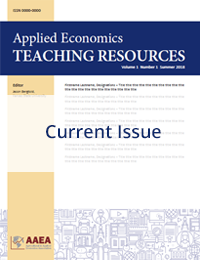Research Article
Impact of COVID-19 Related Transition to Online Instruction on Student Achievement
Jason J. Holderieath(a), Michael K. Crosby(a), T. Eric McConnell(b), and D. Paul Jackson(a)
Louisiana Tech University(a), Mississippi State University(b)
JEL Codes: A22
Keywords: COVID-19, education, online course delivery, scholarship of learning
First Published Online: March 25, 2021
Volume 3, Issue 1
Abstract
Distance education and online delivery of course materials are not new in the United States. However, the sudden mass movement of entire universities online is new. The COVID-19 pandemic forced many universities to move their instruction online, over a weekend in some cases. This article explores the effects on student achievement by estimating a Poisson model of course grade outcomes to find that Spring 2020 term was not statistically significant in its effects on students completing the course, passing the course, and earning an “A†in the course. Graphically analyzed, the data show a possibility of different types of effects for different students, courses, and professors. Further research with more data is needed to understand the effect entirely.
References
Beaudoin, M. 1990. “The Instructor’s Changing Role in Distance Education.” The American Journal of Distance Education 4(2):21–29.
Bower, B.L. 2001. “Distance Education: Facing the Faculty Challenge.” Online Journal of Distance Learning Administration 4(2). Available from https://www.westga.edu/~distance/ojdla/summer42/bower42.html. Center for Instructional Technology. “[Facstaff-l] Instructional Technology Update—3/20/20.’”
Frederickson, N., P. Reed, and V. Clifford. 2005. “Evaluating Web-Supported Learning Versus Lecture-Based Teaching: Quantitative and Qualitative Perspectives.” Higher Education 50:645–664. https://doi.org/10.1007/s10734-004-6370-0
Greene, William H. 2012. Econometric Analysis. 7th. ed. Germany: Prentice Hall.
“Interim Emergency Policy for Academics Spring Quarter 2020, COVID-19.” 2020. https://www.latech.edu/documents/2020/03/2020-interim-emergency-policy.pdf/#:~:text=Withdrawal Date,%2C to May 15%2C 2020.
Lewis, L., D. Alexander, E. Farris, and B. Greene. 1997. “Distance Education in Higher Education Institutions.” NCES 98-062. U.S. Department of Education, National Center for Education Statistics. Washington DC. https://nces.ed.gov/pubs98/98062.pdf.
MacKinnon, J.G., and H. White. 1985. “Some Heteroskedasticity-Consistent Covariance Matrix Estimators With Improved Finite Sample Properties.” Journal of Econometrics 29(3):305–325.
Oomen-Early, J., and L. Murphy. 2009. “Self-Actualization and E-learning: A Qualitative Investigation of University Faculty’s
Perceived Needs for Effective Online Instruction.” International Journal on E-Learning 8(2):223–240.
Otter, R.R., S. Seipel, T. Graeff, B. Alexander, C. Boraiko, J. Gray, K. Petersen, and K. Sadler. 2013. “Comparing Student and Faculty Perceptions of Online and Traditional Courses.” Internet and Higher Education 19(2013):27–35. https://doi.org/10.1016/j.iheduc.2013.08.001
Roddy, C., D.L. Amiet, J. Chung, C. Holt, L. Shaw, S. McKenzie, F. Garivaldis, J.M. Lodge, and M.E. Mundy. 2017. “Applying Best Practice Online Learning, Teaching and Support to Intensive Online Environments: An Integrative Review.” Frontiers in Education 2:59. https://doi.org/10.3389/feduc.2017.00059
Tucker, S. 2001. “Distance Education: Better, Worse, or as Good as Traditional Education?” Online Journal of Distance Learning Administration 4(4). Available from http://www.westga.edu/~distance/ojdla/winter44/tucker44.html.
University Registrar. 2020. “Spring Quarter 2020.” https://www.latech.edu/documents/2018/07/spring-quarter-2020.pdf/. “Update for Students. Louisiana Tech University.” 2020. https://www.latech.edu/coronavirus/messages/update-for-students/.
White, H. 1980. “A Heteroskedasticity-Consistent Covariance Matrix Estimator and a Direct Test for Heteroskedasticity.” Econometrica 48(4):817–838.
Wingo, N.P., N.V. Ivankova, and J.A. Moss. 2017. “Faculty Perceptions about Teaching Online: Exploring the Literature Using the Technology Acceptance Model as an Organizing Framework.” Online Learning 21(1):15–35. https://eric.ed.gov/?id=EJ1140242
Zou, G. 2004. “A Modified Poisson Regression Approach to Prospective Studies with Binary Data.” American Journal of Epidemiology 159(7):702–706. https://doi.org/10.1093/aje/kwh090.
Articles in this issue
Course-Related Student Anxiety During COVID-19: A Problem and Some Solutions
Roger Brown, Steve Buck, Michelle Kibler, Jerrod Penn, and Na Zuo
Impact of COVID-19 Related Transition to Online Instruction on Student Achievement
Jason J. Holderieath, Michael K. Crosby, T. Eric McConnell, and D. Paul Jackson
Teaching Principles of Microeconomics with the Economics Media Library
Kelsi Hobbs and Jadrian Wooten
Obtaining Extension Stakeholder Input to Influence Extension Education Programming and Staffing Needs
Caitlinn B. Lineback, Melissa G.S. McKendree, Jeannine P. Schweihofer, and Daniel D. Buskirk
The Feasibility of Investing in a High-Speed Grain-Handling Facility in Kansas
Pedro Masi and Keith Harris


